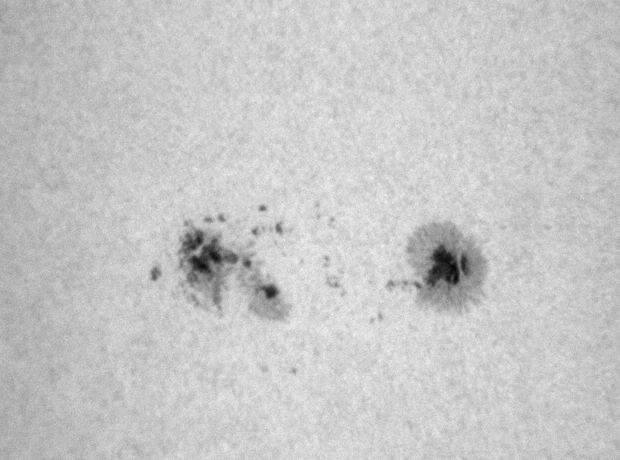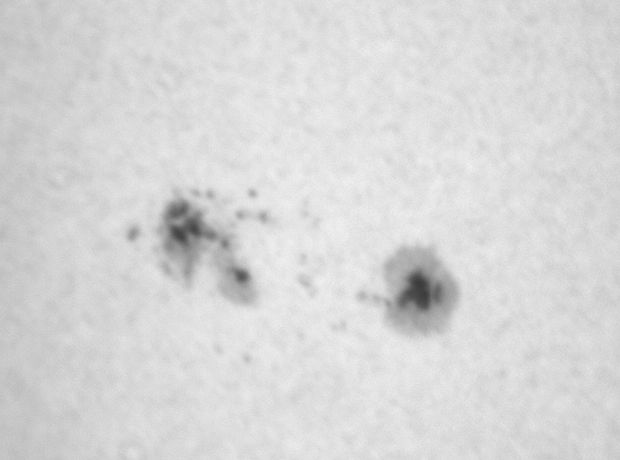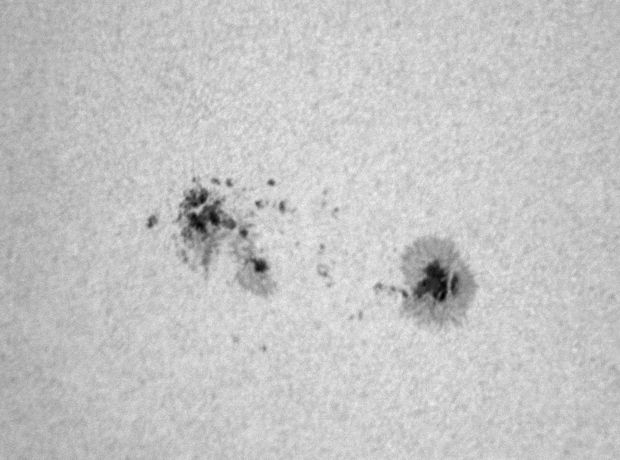

I tried imaging this large sunspot group through narrow-band filters. Here are the results. (For an explanation of the filter designations, see footnote.)

|
Sunspot number 11195 imaged in Hα light (656 nm). I must emphasise that this filter has a 13-nm bandwidth and is not the ultra-narrow band Hα filter used to image solar prominences. Date and Time: 23 April 2011 11:32 UT Camera: DMK 21AF04 Telescope: LX200 Capture: ICCapture. Exposure 1/91", gain 528, 3362 frames Processing: Registax6. 181 frames stacked. Gaussian wavelets 1(0.1,0.07)=100, 2(0.15,0.1)=100, 3(0.44,0.1)=100, Histogram 70-160. |
|

|
Sunspot number 11195 imaged in OIII light (496 & 501 nm). This picture looks out of focus, although I did check focus each time I changed the filter. Move your mouse pointer over the image to see it after fixing out-of-focus blur in Focus Magic. Date and Time: 23 April 2011 11:41 UT Camera: DMK 21AF04 Telescope: LX200 Capture: ICCapture. Exposure 1/91", gain 382, 3406 frames Processing: Registax6. 237 frames stacked. Gaussian wavelets as above. Histogram 20-170. |
|

|
Sunspot number 11195 imaged in SII light (672 & 673 nm) Date and Time: 23 April 2011 11:35 UT Camera: DMK 21AF04 Telescope: LX200 Capture: ICCapture. Exposure 1/91", gain 605, 3338 frames Processing: Registax6. 317 frames stacked. Gaussian wavelets as above. Histogram 57-155. |
|
Footnote
Filters are named after the type of light they transmit. Hα is the α-line in the spectrum of neutral hydrogen and this light is emitted when hydrogen in its lowest excited state reverts to its unexcited state. OIII (pronounced O3) is light emitted by doubly-ionised oxygen. SII (S2) is light emitted by singly-ionised sulphur. These wavelengths of light are characteristically emitted by emission nebulae when gasses in space are illuminated by powerful nearby stars, and these filters are normally used for imaging these nebulae (M42 for example). Their use for the Sun has no relevance to the elements involved because they have much too wide a bandwidth (13 nm) to isolate the emissions from these elements against the massive output of the Sun at all wavelengths. I used them simply as a way of imaging the Sun in a narrow band of wavelengths to see if I got clearer images than when using white light.
Return to top.
Home Back to Sun